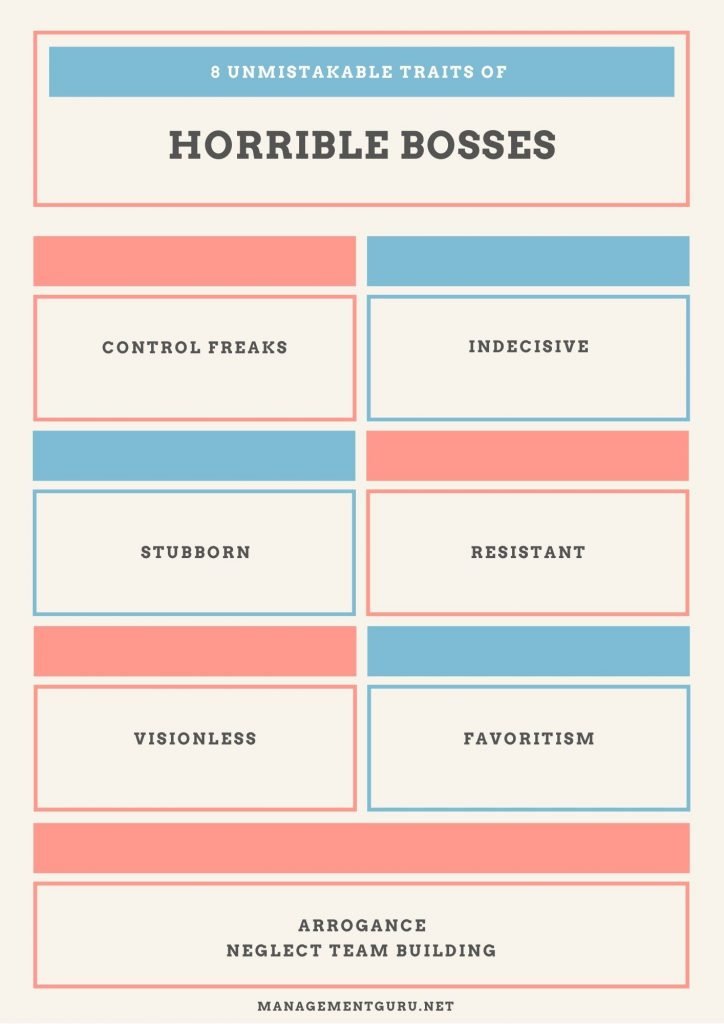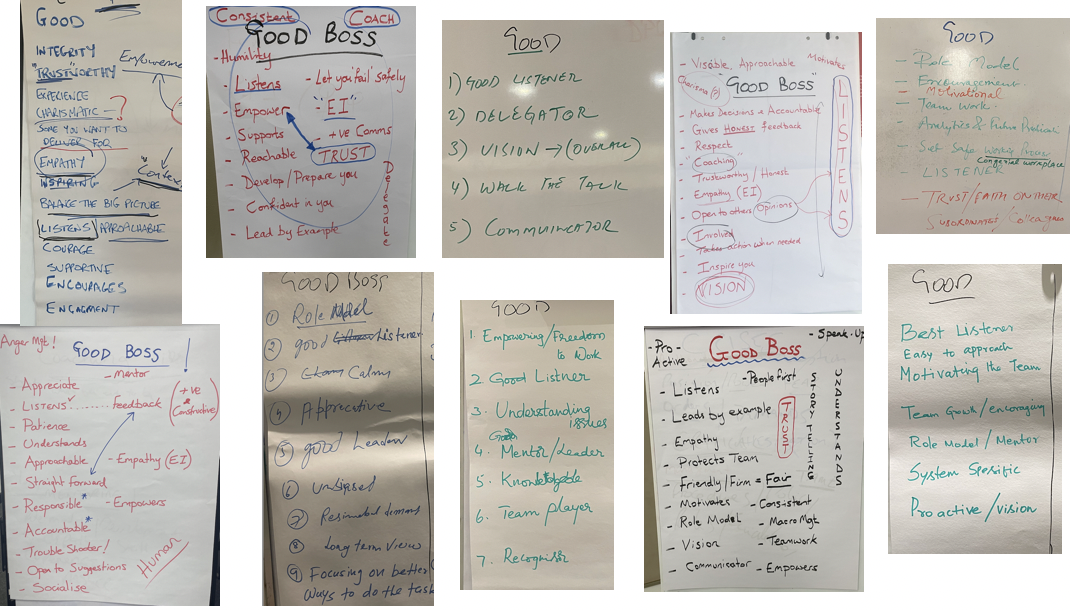Surviving Bad Bosses: Tips for Thriving in Toxic Workplaces

Surviving bad bosses and toxic work environments can be a challenge, but it's not impossible.
With the right mindset and tools, you can thrive in any situation.
This article will provide you with practical tips to help navigate difficult workplace dynamics and make the most of your professional experience.
Quick Summary
- Bad bosses are more common than you think. Many people have experienced a bad boss at some point in their career.
- Bad bosses can have a negative impact on your health. Stress and anxiety caused by a bad boss can lead to physical and mental health problems.
- Bad bosses can hinder your career growth. A bad boss may not provide opportunities for growth or may actively sabotage your career.
- Bad bosses can create a toxic work environment. A bad boss can create a culture of fear, mistrust, and negativity in the workplace.
- Dealing with a bad boss requires strategy and tact. It's important to approach the situation carefully and seek support from colleagues or HR if necessary.
Identifying A Bad Boss

Identifying a Bad Boss:
A bad boss can make your life miserable.
They demand, belittle, and show little interest in their employees' well-being or job satisfaction
- Frequent micromanagement of work that should be handled by others on the team
- Favoritism towards certain members leading to resentment among those left out
- Blaming others when things go wrong instead of taking responsibility
Remember, a bad boss can negatively impact your mental health and job performance.It's important to identify the signs and take action if necessary.
More Signs Of A Bad Boss:
If you're still unsure whether you have a bad boss or not, here are some more indicators:
- Lack of communication with the team
- Setting unrealistic expectations without providing adequate resources
- Failing to recognize good performance while focusing only on mistakes made
- Inconsistent decision-making processes which lead to confusion amongst staff members
Don't let a bad boss hold you back from reaching your full potential.Consider talking to HR or seeking a new job if the situation doesn't improve.
Analogy To Help You Understand
Having a bad boss is like being stuck in a stormy sea with a captain who doesn't know how to navigate. Just like a captain who lacks the skills to steer a ship through rough waters, a bad boss lacks the leadership skills to guide their team through challenging times. They may be quick to blame others for their mistakes, just as a captain might blame the weather for their inability to navigate. Furthermore, a bad boss may be more concerned with their own success than the success of their team, just as a captain may prioritize their own safety over the safety of their crew. Ultimately, a bad boss can leave their team feeling lost and directionless, much like a ship without a captain. It's important to recognize the signs of a bad boss and take action to either improve the situation or find a new captain to guide your ship. After all, a skilled captain can navigate even the roughest seas and lead their crew to success.Coping Mechanisms For Dealing With Toxic Workplaces

How to Cope with Toxic Workplaces
To cope with toxic workplaces, recognize stressors and triggers.
Establish boundaries to protect from negative influences.
Practice self-care routines like yoga or meditation before work, take breaks throughout the day, set realistic goals for yourself and focus on personal growth outside of work.
“Seek support from friends/colleagues who understand what you're going through.Positive relationships can help mitigate negativity in a toxic workplace environment.
Confront problems head-on by addressing concerns with management may lead to changes within the organization.”
Tips:
Some Interesting Opinions
1. Bad bosses are the main reason for employee turnover.
According to a study by Gallup, 75% of employees who quit their jobs do so because of their bosses. This highlights the importance of having good leadership in the workplace.2. Bad bosses cost companies billions of dollars in lost productivity.
A study by the Harvard Business Review found that employees who work for bad bosses are 60% more likely to suffer from heart disease, leading to a loss of productivity and increased healthcare costs for companies.3. Bad bosses are more likely to engage in workplace harassment.
A study by the Workplace Bullying Institute found that 72% of bullies in the workplace are bosses. This highlights the need for companies to have strong anti-harassment policies and training programs.4. Bad bosses are more likely to discriminate against employees.
A study by the National Bureau of Economic Research found that bosses who are white and male are more likely to discriminate against employees who are not white or male. This highlights the need for diversity and inclusion initiatives in the workplace.5. Bad bosses are more likely to create a toxic work environment.
A study by the Society for Human Resource Management found that 58% of employees who work for bad bosses report feeling stressed, and 80% report feeling demotivated. This highlights the need for companies to prioritize employee well-being and mental health.Setting Boundaries With Your Boss

To deal with a bad boss, establish boundaries by setting limits and expectations for how you'll be treated at work.
Identify problematic behaviors like micromanaging or belittling your ideas that can worsen the toxic situation.
- Consider solutions to resolve them
- Speak up assertively if something bothers you
- Communicate clearly about unacceptable behavior and explain why it's problematic
Remember that setting boundaries is not about being confrontational, but rather about creating a healthy work environment for yourself.
Setting boundaries is not about being confrontational, but rather about creating a healthy work environment for yourself.
If your boss continues to cross your boundaries, it may be time to escalate the issue to HR or seek support from a mentor or coach.
Remember that you have the right to be treated with respect and dignity in the workplace.
You have the right to be treated with respect and dignity in the workplace.
Seeking Support From Colleagues And Friends

Building a Support Network in a Toxic Work Environment
In a toxic work environment, seeking support from colleagues and friends is crucial.
They can provide emotional assistance, feedback on your work, and help navigate difficult situations.
It's important to have a supportive system that understands what you're going through.
If there are coworkers who share your struggle with the bad boss or negative workplace culture, open up about how their behaviors affect everyone's work quality.Ensure they understand it concerns the entire team/department - not just one person.
Alternatively, guidance from someone outside of work (family/close friend) may offer needed perspective.
Building Your Support Network
Here are some ways to build a support network:
- Schedule regular check-ins with understanding coworkers for constructive support
- Seek out networking groups where people share similar experiences
- Join professional organizations supporting employees fighting harmful environments
Remember, having a support network can make all the difference in a toxic work environment.Don't be afraid to reach out for help.
My Experience: The Real Problems
1. Bad bosses are not the root cause of workplace problems.
According to a study by Gallup, only 13% of employees worldwide are engaged at work. This suggests that the real problem lies in the overall work culture and management practices.2. The concept of a "bad boss" is subjective and varies from person to person.
A survey by CareerBuilder found that 37% of employees have left a job because of a bad boss. However, what one person considers a bad boss may not be the same for another.3. Employees need to take responsibility for their own career growth and development.
A study by LinkedIn found that 93% of employees would stay at a company longer if it invested in their careers. This suggests that employees need to take ownership of their own growth and development, rather than relying solely on their boss.4. The traditional hierarchical structure of organizations is outdated and ineffective.
A study by Deloitte found that 92% of organizations believe that redesigning their organizational structure is very important or important. This suggests that the traditional top-down approach to management is no longer effective in today's fast-paced and dynamic work environment.5. The solution to workplace problems lies in creating a culture of trust, transparency, and open communication.
A study by Edelman found that 64% of employees do not trust their employer. This suggests that creating a culture of trust, transparency, and open communication is crucial in addressing workplace problems and improving employee engagement and retention.Documenting Incidents Of Bad Behavior

Protect Your Career: Document Incidents of Bad Behavior from Superiors
To protect your career, document any incidents of bad behavior from superiors.
This includes unprofessionalism, discrimination, or abuse in the workplace.
Compile evidence for future use.
When documenting incidents, be detailed with dates and times along with what was said or done by your boss.
Record how it made you feel at the time and its impact on work performance since then.
More information strengthens a case.
Tips for Documenting Incidents
- Use specific examples
- Keep documentation confidential
- Ensure accuracy
Remember, documentation is key to protecting yourself and your career.
By keeping a record of any incidents, you can provide evidence if necessary and protect yourself from any negative consequences.
“Documentation is key to protecting yourself and your career.”
Make sure to keep your documentation confidential and secure.
Only share it with trusted individuals, such as a lawyer or HR representative, if necessary.
Accuracy is also crucial when documenting incidents.
Double-check your dates, times, and details to ensure that your records are reliable and trustworthy.
Communicating Effectively With Your Boss

Establish Clear Communication with Your Boss
When communicating with your boss, it's important to establish clear communication from the start.
Actively listen and ask clarifying questions to avoid misunderstandings.
Regularly Update Your Boss on Project Progress
Transparency builds trust, which is critical in toxic work environments where mistrust is common.
Regularly update your boss on project progress or roadblocks that may impact deadlines.
Tips for Effective Communication with Your Boss
- Stay focused: Keep the conversation on topic and avoid getting sidetracked.
- Ask for clarification: If you're unsure about something, ask for clarification to avoid misunderstandings.
- Be open to feedback/criticism: Listen to your boss's feedback and take it as an opportunity to improve.
- Share project status transparently: Be honest about project progress and any challenges you're facing.
- Build trust through honesty: Trust is built through honesty, so be truthful in your communication with your boss.
My Personal Insights
As the founder of AtOnce, I have had my fair share of experiences with bad bosses. However, one particular experience stands out to me as a turning point in my career. I was working for a startup at the time, and my boss was incredibly demanding. He would constantly change the scope of my work, and I found myself working long hours just to keep up with his demands. I was stressed out and burnt out, and I knew that something had to change. That's when I decided to use AtOnce to help me communicate with my boss. I started using the AI writing tool to draft emails and messages to him, and I was amazed at how much easier it made my life. With AtOnce, I was able to clearly articulate my thoughts and concerns to my boss without getting bogged down in the details. The tool helped me to stay focused and on track, and it gave me the confidence to stand up for myself and my work. Over time, I noticed a significant improvement in my relationship with my boss. He started to respect my boundaries and my time, and he even began to trust me more with important projects. Looking back on that experience, I realize just how powerful a tool like AtOnce can be. It helped me to navigate a difficult situation with grace and professionalism, and it gave me the confidence to take control of my career. If you're dealing with a bad boss, I highly recommend giving AtOnce a try. It just might be the key to unlocking your full potential and achieving success in your career.Avoiding Triggers That Exacerbate The Situation

How to Deal with a Bad Boss
Identify and avoid triggers that may set off your bad boss to prevent exacerbating the situation.
Triggers could be certain topics, actions, or tone of voice.
For example, don't discuss ideas that cause negative reactions from your boss.
Prevent triggering by being respectful but assertive while setting boundaries for yourself.
Speak up calmly if something inappropriate is about to happen without being confrontational.
Keep good documentation on any issues for clarity later on.
Approach HR with strong evidence.
Don’t let emotions dictate handling situations.
Remember, you have rights as an employee and should not tolerate any form of abuse or harassment.
Seek support from colleagues or a professional if necessary.
Prioritizing Self Care To Improve Resilience At Work

Why Prioritizing Self-Care is Crucial for Resilience at Work
Self-care is essential for improving resilience at work.
Neglecting it in a toxic workplace or under bad bosses can harm your mental health and hinder growth.
Here are some tips to prioritize self-care:
Set Clear Boundaries
- Avoid checking emails after work hours
- Take breaks throughout the day
- Pursue hobbies outside of work to decompress
Practice Good Sleep Hygiene
Getting enough sleep is crucial for your mental and physical health.
Here are some tips to improve your sleep hygiene:
- Establish a consistent bedtime routine
- Avoid caffeine before bed
- Turn off screens an hour before sleeping
Use Stress-Reducing Techniques
Stress can take a toll on your mental and physical health.
Here are some techniques to reduce stress:
Mindfulness meditation can help reduce stress and improve focus.
- Harvard Business Review
Creating An Exit Strategy And Identifying New Opportunities

How to Leave a Toxic Workplace
If you're in a toxic workplace, it's time to create an exit strategy.
Here are some steps to help you leave:
Step 1: Identify Your Goals
First, identify why you want to leave and what work situation suits you best.
This will help you stay focused and motivated during your job search
Step 2: Research Your Options
Research other organizations or industries before deciding on your next move.
Determine potential employers in the field that works for you.
Conduct informational interviews with people doing similar work to learn more about their experiences and how they succeed.
Step 3: Take Action
Understanding Legal Protections For Employees In Toxic Environments

Legal Protections for Employees in Toxic Environments
Employees working in toxic environments are protected by various laws.
If you're experiencing harassment, discrimination, or mistreatment at work, it can be challenging to know where to turn first.
Different laws may apply depending on the situation and location.
- Title VII of the Civil Rights Act is a major law that protects workers from discrimination based on characteristics such as race, sex, and religion among others.
- The Americans with Disabilities Act (ADA) requires employers to provide reasonable accommodations for individuals with disabilities so they can perform their jobs effectively.
Employers must respond immediately when an employee complains about an unsafe or hostile work environment legally.
An employer could potentially face legal action if they believe errors were made during firing procedures by any employee who feels wronged.
Different laws may apply depending on the situation and location.
It's important to know your rights as an employee and what legal protections are available to you.
If you're experiencing harassment, discrimination, or mistreatment at work, consider reaching out to a lawyer or a relevant government agency for assistance.
Employers must respond immediately when an employee complains about an unsafe or hostile work environment legally.
Remember, you have the right to a safe and healthy work environment, and there are laws in place to protect you.
Don't hesitate to seek help if you need it.
Utilizing Resources Available Through Human Resources Or Management
Dealing with Bad Bosses: Utilizing Available Resources
When faced with a difficult boss, it's important to know that you're not alone.
There are resources available to help you navigate the situation and advocate for your rights as an employee.
HR and Management Channels
One of the most important resources available to you is your company's HR department.
HR professionals can provide guidance on legal rights, mediate disputes between employees and managers, and explain company policies regarding harassment and discrimination.
They may also be able to offer advice on transferring to a different team within the company to ensure better working conditions.
It's important to familiarize yourself with your company's HR guidelines and policies.
This will help you understand your rights and the steps you can take to address any issues with your boss.
Document Incidents of Abuse
If you're experiencing abuse or mistreatment from your boss, it's important to document every incident.
This will help you build a case if you need to file a complaint or take legal action.
Keep a record of dates, times, and details of each incident.
Follow Up Promptly
If you do file a complaint with HR or management, it's important to follow up promptly.
This shows that you're taking the situation seriously and that you expect action to be taken.
Keep track of any communication you have with HR or management regarding the issue.
Building Positive Relationships With Co Workers To Create A Supportive Environment
Building Positive Relationships in the Workplace
To create a supportive work environment, it's crucial to build positive relationships with co-workers.
This fosters cooperation and teamwork while providing support during stressful times.
Steps for Building Constructive Relationships
- Find common ground: Look for shared interests or values
- Be proactive: Arrange team-building activities like happy hours or volunteer events
- Communicate effectively: Listen attentively without interrupting when someone speaks
Remember, building positive relationships takes time and effort, but the benefits are worth it.
When you have positive relationships with your co-workers, you'll experience:
- Increased job satisfaction
- Improved communication
- Greater productivity
- Enhanced creativity and innovation
Take the time to invest in your relationships with your co-workers, and you'll see the positive impact it has on your work environment.
So, start today by finding common ground, being proactive, and communicating effectively.
Final Takeaways
As a founder of a startup, I have had my fair share of experiences with bad bosses. I remember one boss who would constantly micromanage every aspect of my work, leaving me feeling suffocated and unappreciated. Another boss would never give me clear instructions, leaving me confused and frustrated. And yet another boss would take credit for my work, leaving me feeling undervalued and unimportant. These experiences taught me the importance of being a good boss myself. I wanted to create a work environment where my employees felt valued, appreciated, and heard. That's why I created AtOnce - an AI writing and AI customer service tool that helps businesses communicate effectively with their customers. With AtOnce, businesses can provide their customers with quick and accurate responses to their inquiries, without the need for human intervention. But AtOnce isn't just a tool for businesses. It's also a tool for bosses who want to be better leaders. By using AtOnce, bosses can communicate more effectively with their employees, providing them with clear instructions and feedback in a timely manner. AtOnce can also help bosses recognize the hard work and achievements of their employees, boosting morale and creating a positive work environment. As a boss myself, I know how important it is to be a good leader. And with AtOnce, I can be confident that I am providing my employees with the support and guidance they need to succeed. So if you're a boss who wants to be better, or a business that wants to improve its customer service, give AtOnce a try. You won't be disappointed.Are you tired of staring at a blank page, wondering how to write that high-converting ad for your product or service?
Do you struggle with finding the right words to describe your business to potential customers? Are you spending hours editing and proofreading your emails and blog posts, only to still find mistakes? Say goodbye to those frustrating moments with AtOnce's AI writing tool! Addressing Your Frustrations- Do you find yourself struggling with writer's block?
- Are you unable to put your thoughts into words?
- Do you spend hours writing and editing your content, only to still find errors?
- Are you looking for an easy and quick solution to improve your writing?
- Effortlessly create high-quality content without writer's block.
- Get polished results with minimal effort.
- Save time with fast content creation.
- Improve your writing skills with personalized insights.
- Boost your conversions with highly convincing content.
What are some signs of a toxic workplace?
Some signs of a toxic workplace include high turnover rates, lack of communication, micromanagement, favoritism, and lack of support from management.
How can I cope with a bad boss?
You can cope with a bad boss by setting boundaries, focusing on your work, seeking support from colleagues, documenting any issues, and considering speaking with HR or a higher-up manager.
What are some strategies for thriving in a toxic workplace?
Some strategies for thriving in a toxic workplace include focusing on your own goals and growth, seeking out positive relationships with colleagues, practicing self-care, and considering finding a new job if the toxicity becomes too much to handle.
